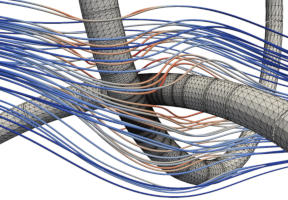Principal author Dhairya Malhotra, with additional code by Alex Barnett. This work was done at the Center for Computational Mathematics at the Flatiron Institute, NY, NY.
This is a high-performance parallel C++ implementation of a high-order adaptive Nyström quadrature for the boundary integral equations arising in 3D Laplace and Stokes Dirichlet and rigid mobility boundary-value problems for closed loop filaments of arbitrarily small circular cross-section. Its quadrature setup cost is independent of the slenderness parameter, being around 20000 unknowns/sec per core, at 6-digit accuracy, away from close-to-touching regions. Close-to-touching geometries may be handled to close to machine accuracy using adaptivity. Open-ended fibers with rounded ends are possible and will be added soon.
This repository also contains MATLAB codes implementing the classical slender-body theory asymptotic approximation, and solving its linear inverse problem as needed for a mobility solve.
It is research software; use at your own risk. The following figures show some of the capabilities of the code (see the preprint below for details).
Stokes flow solution around rigid slender fiber with aspect ratio
Stokes flow solution near close-to-touching rings, max error
Sedimentation of 512 rings each of aspect ratio 20, timestepped to 7-digit accuracy on 160 cores:
C++ compiler that supports C++11 standard
BLAS, LAPACK, FFTW, MPI (distributed memory parallelism), PVFMM
git clone https://github.com/dmalhotra/CSBQ.git
cd CSBQ
git submodule init
git submodule update
# update Makefile as necessary
make
./bin/demo1-geometryFor visualization do (after installing PARAVIEW):
make && ./bin/demo1-geometry && paraview vis/ring.pvtuThis is a header-only C++ library: you only need to #include <csbq.hpp> in your code.
It relies on the SCTL library (included as a submodule) and the path to sctl.hpp must be provided to the C++ compiler.
The included Makefile may be used as a template for new projects.
Everything is contained within sctl:: namespace.
Demo codes for learning to use the library are provided in tutorial/.
Precomputed quadrature tables for Laplace and Stokes kernels and some geometry files are provided in data/.
Test codes used to generate the results in the paper are provided in test/, along with SLURM scripts in scripts/.
For slender-body numerical implementations in MATLAB, see SBT/ directory.
If you find this code useful in your research, please cite our preprint, "Efficient Convergent Boundary Integral Methods for Slender Bodies," Dhairya Malhotra and Alex Barnett, arXiv:2310.00889, submitted, J. Comput. Phys. (2023).


